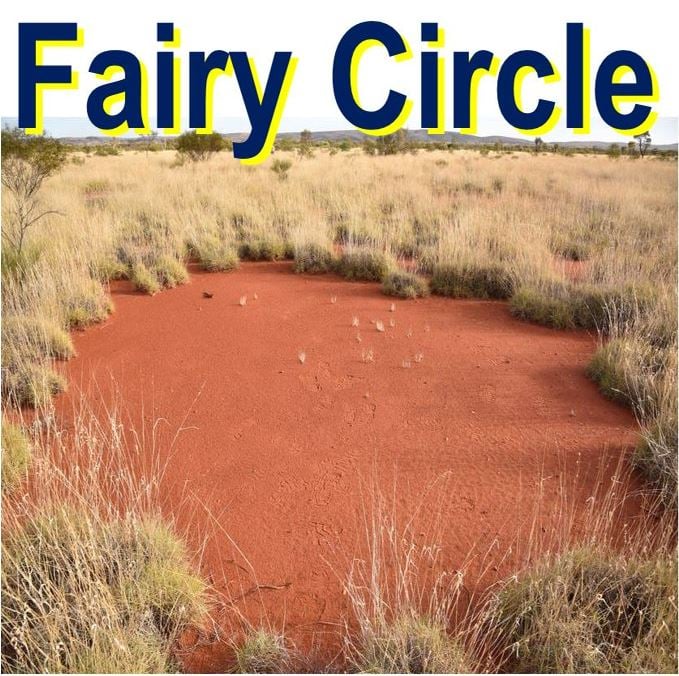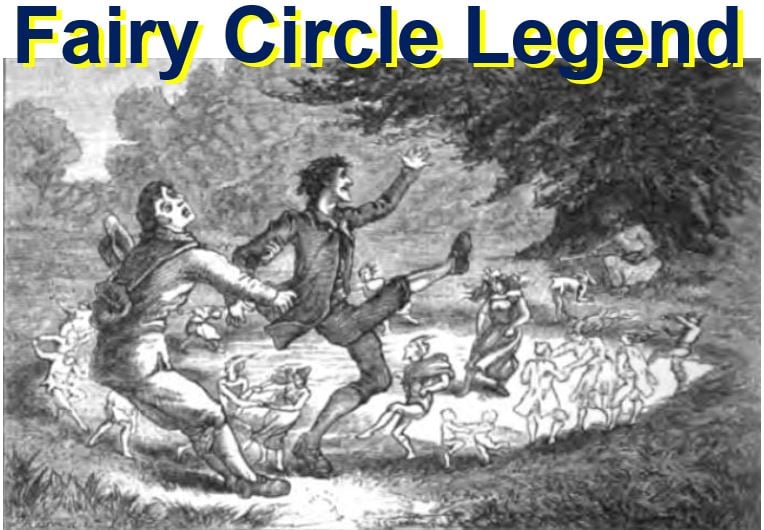The fairy circle mystery – round and barren patches of land forming highly-regular patterns – has probably been solved, says an international team of scientists, whose members believe they exist as a result of plants responding to water shortages, and not because of insects chewing the roots of the grass, aliens playing tricks, or angry fiery dragons.
Fairy circles were once thought to only exist in Namibia in Southern Africa, but scientists from Germany, Israel and Australia wrote in the journal Proceedings of the National Academy of Sciences (PNAS) that they discovered these enigmatic structures in the remote Australian outback too.
Fairy circle expert, Dr. Stephan Getzin, who works at the Helmholtz Centre for Environmental Research (UFZ) in Leipzig, Germany, and colleagues say they have provided new evidence suggesting that these fairy circles occur because of the way plants organize themselves when conditions are or become arid – when water is scarce.
 A large fairy circle in Australia with a hardened top-soil layer that prevents the growth of grass. Fairy circles in Australia have mean diameters of 4 metres (13.1 feet) – but some may exceed 7 metres (23 feet). (Image: ufz.de. Credit: Dr. Stephan Getzin)
A large fairy circle in Australia with a hardened top-soil layer that prevents the growth of grass. Fairy circles in Australia have mean diameters of 4 metres (13.1 feet) – but some may exceed 7 metres (23 feet). (Image: ufz.de. Credit: Dr. Stephan Getzin)
All started with an aerial photograph
The scientists got to know about the natural phenomenon outside Namibia when an Australian colleague sent them an aerial photograph of the region surrounding the town of Newman, in the Pilbara region of Western Australia.
The image showed plant patterns that were eerily similar to the Namibian fairy circles.
Over the centuries, there have been dozens of theories as to how these barren circles with grass on their edges came about, from aliens sending us or each other messages, dragons breathing fire, to ants or termites.
Those supporting the ants/termites theory suggested that the insects nibbled away at the roots of grasses, which consequently killed the plants.
 Aerial view of the Australian fairy circles which spread homogeneously over the landscape covering a vast area. (Image: ufz.de. Credit: Kevin Sanders)
Aerial view of the Australian fairy circles which spread homogeneously over the landscape covering a vast area. (Image: ufz.de. Credit: Kevin Sanders)
Some scientists believe that carbon monoxide (a toxic gas) made its way to the Earth’s surface from deep down, and killed off vegetation.
One study suggested that the barren areas simply emerged of their own accord under certain conditions.
Result of lack of water
In areas of land at the transition between grassland and desert, there is not enough water available for total vegetation cover. So each plant competes for the scarce water, and organize themselves in this characteristic carpet of grass with large dry patches scattered around.
Dr. Getzin has supported this last theory for several years, especially after looking at aerial photographs of the landscapes. In previous studies, he analyzed the exact location of the so-called fairy circles.
Dr. Getzin said:
“The interesting thing about fairy circles is that they are spread with great regularity and homogeneity, even over vast areas, but they occur only within a narrow rainfall belt.”
 The fairy circles in Namibia are virtually identical to the ones found in Australia. According to Walter Tschinkel, from Florida State University, they can last from 24 to 75 years and range from about 6 to 30 feet (1.8 to 9.4 metres) in diameter. They start off as bare spots on an otherwise continuous grass carpet. (Image: neatorama.com)
The fairy circles in Namibia are virtually identical to the ones found in Australia. According to Walter Tschinkel, from Florida State University, they can last from 24 to 75 years and range from about 6 to 30 feet (1.8 to 9.4 metres) in diameter. They start off as bare spots on an otherwise continuous grass carpet. (Image: neatorama.com)
He is convinced that this pattern, which looks very much like the six-sided structure of honeycombs, is probably the result of competition for scarce water.
Dr. Getzin, together with co-authors Ehud Meron and Hezi Yizhaq, from Ben-Gurion University of Negev in Israel, have carried out computer simulations which confirmed his appraisal.
Dr. Getzin said:
“For a long time, ecologists weren’t convinced that plants in dry areas could organize themselves because the theoretical principles for these processes lie in physics. But it has since become increasingly clear how important this process is.”
 A great deal of folklore surrounds fairy circles, also called fairy rings. In this sketch, a man saves his friend from the grip of a fairy circle. (Image: Wikipedia)
A great deal of folklore surrounds fairy circles, also called fairy rings. In this sketch, a man saves his friend from the grip of a fairy circle. (Image: Wikipedia)
Many scientists were not convinced at first
Not all Dr. Getzin’s colleagues were convinced. Some wondered why there weren’t lots of other similar fairy circles around the world. There are many places across the globe with similar semi-arid environments. It was not only in the grasslands of Namibia where plants competed for water.
We all know that drought causes interesting vegetation patterns in other areas too, the skeptics said. But fairy circles with such a regular six-sided structure appeared nowhere else on Earth.
That was why Dr. Getzin was so overjoyed when he received the aerial photograph from Australia in 2014. He and Yizhaq went to Australia to look at the phenomenon more closely.
Australian visit confirmed his theory
They measured the lifeless circles, compared their surface temperature with surfaces in vegetated areas, and charted indications of termites and ants in four parts of the quasi-uninhabited region.
They studied the drainage of water in these areas and took soil samples so that they could be later analyzed in the lab.
They also took more aerial photographs and studied them, carried out statistical analyses of the landscape patterns, and performed computer simulations.
Following their comprehensive investigation, they were convinced that these were just like the fairy circles 10,000 kilometres (6,213 miles) away in Namibia.
No ants/termites in Australian fairy circles
The scientists say they have discovered new evidence confirming their theory on how the fairy circles arise. While in Namibia there are up to three species of ants or termites crawling around in or on the fairy circles, in Australia the situation is clearer – there were virtually no ant or termite nests.
Dr Getzin said:
“There we found in the majority of cases no nests in the circles and unlike in Namibia, cryptic sand termites do not exist in Australia. And the ones we did find have a completely different distribution pattern to the fairy circles.”
This factor was enough to convince him that the fairy circles had nothing to do with insects, and more to do with how the plants organize themselves.
The researchers also found that the Triodia genus found on the land around the fairy circles also formed other typical drought patterns such as labyrinths, stripes or spot patterns, with individual plants surrounded by barren Earth.
Labyrinth and stripe patterns tend to form on hard soil layers with overland-water flow, as is typically observed with lined-up trees along mountain slopes.
The scientists have also gained insight into how the vegetation and soil interact across this region. If Australia’s loamy soil is not protected by vegetation, its surface gets extremely hot and bakes to a hard virtually impermeable crust – water finds it nearly impossible to penetrate.
A self-perpetuating process
When it does rain – which is not often – the water flows away over the surface, thus making conditions far from ideal for germinating plants; so the areas remain barren. Things are quite different where the first grasses are growing.
Where there are plants present, the surface is much cooler and the soil looser, so rainwater seeps in easily. This makes it possible for other plants to colonise the area, which further improves conditions – it’s a small-scale, self-perpetuation process which results in the grass carpet with barren fairy circles scattered about covering large areas.
Dr. Getzin said:
“In Namibia, the sandy soils of the fairy circles are much more permeable and precipitation can drain away with ease.”
Reservoirs therefore form under the barren areas, supplying the surrounding grass with water via diffusion processes within the soil.
Dr. Getzin explained:
“The details of this mechanism are different to that in Australia,” he explains. “But it produces the same vegetation pattern because both systems of gaps are triggered by the same instability.”
Dr. Getzin believes that fairy circles probably exist in other parts of the world – uninhabited or sparsely-inhabited regions where conditions are dry. He aims to investigate further and find them.
Citation: “Discovery of fairy circles in Australia supports self-organization theory,” Stephan Getzin, Hezi Yizhaq, Bronwyn Bell, Todd E. Erickson, Anthony C. Postle, Itzhak Katra, Omer Tzuk, Yuval R. Zelnik, Kerstin Wiegand, Thorsten Wiegand, and Ehud Meron. Proceedings of the National Academy of Sciences (PNAS). 14 March 2016. DOI: 10.1073/pnas.1522130113.
Video – Fairy circles found in Australia
